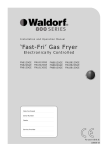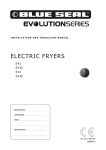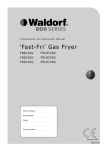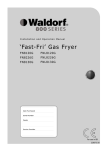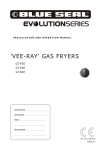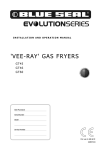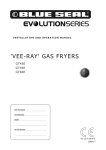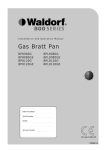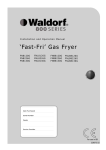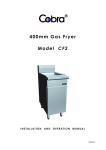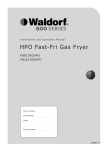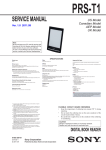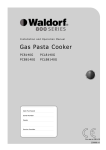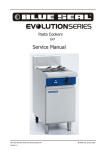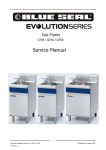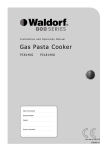Download Waldorf FN8130GE Specifications
Transcript
Installation and Operation Manual ‘Fast-Fri’ Gas Fryer Electronically Controlled FN8120GE FNL8120GE FN8226GE FNL8226GE FN8130GE FNL8130GE Date Purchased Serial Number Dealer Service Provider For use in GB & IE 1 228638-12 MANUFACTURED BY Moffat Limited PO Box 10001 Christchurch New Zealand Ph: (03) 389 1007 Fax: (03) 389 1276 WORLD-WIDE BRANCHES UNITED KINGDOM Blue Seal 67 Gravelly Business Park Gravelly Park Birmingham West Midlands B24 8TQ Ph: (121) 327 5575 Fax: (121) 327 9711 UNITED STATES Moffat Inc 3765 Champion Blvd Winston-Salem North Carolina 27115 Ph: (336) 661 0257 Fax: (336) 661 9546 CANADA Serve Canada 22 Ashwarren Road Downview Ontario M3J1Z5 Toll Free:800 263 1455 Ph: (416) 631 0601 Fax: (416) 631 0315 [email protected] www.servecanada.com www.moffat.com NEW ZEALAND Christchurch Moffat Limited PO Box 10-001 16 Osborne Street Christchurch Ph: (03) 389 1007 Fax: (03) 389 1276 Auckland Moffat Limited 4 Waipuna Road Mt Wellington Auckland Ph: (09) 574 3150 Fax: (09) 574 3159 AUSTRALIA Victoria Moffat Pty Limited 740 Springvale Road Mulgrave, Melbourne Victoria 3171 Ph: (03) 9518 3888 Fax: (03) 9518 3838 New South Wales Moffat Pty Limited 3/142 James Ruse Drive, Rose Hill PO Box 913, Smithfield Sydney, N.S.W. 2142 Ph: (02) 8833 4111 Fax: (02) 8833 4133 Western Australia Moffat Pty Limited 67 Howe Street Osbourne Park WA 6017 Ph: (08) 9202 6820 Fax: (08) 9202 6836 Queensland Moffat Pty Limited 30 Prosperity Place Geebung, Brisbane Queensland 4034 Ph: (07) 3630 8600 Fax (07) 3630 8623 The reproduction or copying of any part of this manual by any means whatsoever is strictly forbidden unless authorized previously in writing by the manufacturer. In line with policy to continually develop and improve its products, Moffat Ltd. reserves the right to change the specifications and design without prior notice. © Copyright Moffat 2 Ltd. January 2010. Contents FN(L)8120GE ‘FAST FRI’ GAS FRYER FN(L)8226GE ‘FAST FRI’ GAS FRYER FN(L)8130GE ‘FAST FRI’ GAS FRYER (Single Tank - 20Ltr) (Twin Tank - 26Ltr) (Single Tank - 31Ltr) Introduction ............................................................................................ 3 Specifications .......................................................................................... 4 Model Numbers Covered in this Specification. General. Optional Accessories. Gas Supply Requirements. Gas Connection. Electrical Supply Requirements. Electrical Connection. Dimensions ............................................................................................... 7 Installation ............................................................................................... 9 Installation Requirements. Unpacking. Location. Clearances. Assembly. Fitting Rear Rollers. Gas Connection. Electrical Connection. Commissioning. Operation................................................................................................ 14 Operation Guide. Description of Controls. Description of the Electronic Control Panel. Operation of the Appliance. Before Use. Filling the Tank(s). Lighting the Pilot Burners. Lighting the Main Burners. Turning 'OFF' the Fryer. Setting the Operating Temperature. Frying Guide and Care of Frying Oils and Fats. Frying Temperature Guide and Care of Frying Medium. Cleaning and Maintenance ..................................................................... 24 General. Draining and Cleaning. Daily Cleaning. Weekly Cleaning. Periodic Maintenance. Fault Finding........................................................................................... 27 Wiring Schematics .................................................................................. 31 Contents Controller Basic Programming Mode ..................................................... 34 Programming the Password Protection. Programming the Timers. Programming the Temperature. Programming the Keypad Lock - Unlock. To Exit the Programming Mode. Controller Advanced Programming Mode .............................................. 37 Timing Mode. Temperature Offset. Temperature Display Mode. Programming the Melt Cycle. Setting the Temperature Units. System Programmable Default Settings. Gas Conversion and Specifications ........................................................ 41 Conversion Procedure. Gas Specifications. Replacement Parts List .......................................................................... 43 Introduction We are confident that you will be delighted with your Waldorf ‘Fast-Fri’ Gas Fryer and it will become a most valued appliance in your commercial kitchen. To ensure you receive the utmost benefit from your new Waldorf ‘Fast-Fri’ Gas Fryer, there are two important things you can do. Firstly Please read the instruction book carefully and follow the directions given. The time taken will be well spent. Secondly If you are unsure of any aspect of the installation, instructions or performance of your Fryer, contact your WALDORF dealer promptly. In many cases a phone call could answer your question. CE Only These instructions are only valid if the country code appears on the appliance. If the code does not appear on the appliance, refer to the supplier of this appliance to obtain the technical instructions for adapting the appliance to the conditions for use in that country. WARNING: IMPROPER INSTALLATION, ADJUSTMENT, ALTERATION, SERVICE OR MAINTENANCE CAN CAUSE PROPERTY DAMAGE, INJURY OR DEATH. READ THE INSTALLATION, OPERATING AND MAINTENANCE INSTRUCTIONS THOROUGHLY BEFORE INSTALLING OR SERVICING THIS APPLIANCE. WARNING: INSTRUCTIONS TO BE FOLLOWED IN THE EVENT THE USER SMELLS GAS ARE TO BE POSTED IN A PROMINENT LOCATION. THIS INFORMATION SHALL BE OBTAINED BY CONSULTING THE LOCAL GAS SUPPLIER. WARNING: GREAT CARE MUST BE TAKEN BY THE OPERATOR TO USE THE EQUIPMENT SAFELY TO GUARD IT AGAINST RISK OF FIRE. THE APPLIANCE MUST NOT BE LEFT ON UNATTENDED. IT IS RECOMMENDED THAT A REGULAR INSPECTION IS MADE BY A COMPETENT SERVICEMAN TO ENSURE CORRECT AND SAFE OPERATION OF YOUR APPLIANCE IS MAINTAINED. DO NOT STORE OR USE GASOLINE OR OTHER FLAMMABLE VAPOURS OR LIQUIDS IN THE VICINITY OF THIS OR ANY OTHER APPLIANCE. •DO NOT SPRAY AEROSOLS IN THE VICINITY OF THIS APPLIANCE WHILE IT IS IN OPERATION. CAUTION: This appliance is; • For professional use and is to be used by qualified persons only. • Only authorised service persons are to carry out installation, servicing and gas conversion operations. • Components having adjustments protected (e.g. paint sealed) by the manufacturer should not be adjusted by the user / operator. • DO NOT operate the appliance without the legs supplied fitted. 3 Specifications Model Numbers Covered in this Specification FN[1]8120GE FN[1]8226GE FN[1]8130GE ‘FAST FRI’ GAS FRYER ‘FAST FRI’ GAS FRYER ‘FAST FRI’ GAS FRYER (Single Tank - 20Ltr). (Twin Tank - 26Ltr per Tank). (Single Tank - 31Ltr). NOTE: [1]: - Back Options; L - Standard Models. - Low Back Models. General A commercial heavy duty, gas fired Fryer having a fast fry infra red burner system which an intense even heat through the tank. It is available in 3 model types. All model types are fitted with dual main burners and pilot burners, with the single tank models fitted with a single gas controller which controls both pilot and main burners where the twin tank model is fitted with twin gas controllers which work independently for each burner. These Fryers feature an Over Temperature Safety Cut Out system with Full Flame Failure Safety Controls. A programmable controller with digital display and electronic temperature control. Twin programmable timers and melt cycle programs. An open tank design for both single and twin tank units to make cleaning a simple and easy task. Optional Accessories This appliance can be fitted with the following optional accessories, (refer to the 'Replacement Parts List' for details). • Plinth Kit. Gas Supply Requirements - Australia / New Zealand Only: Input Rating (N.H.G.C.) Supply Pressure Operating Pressure Natural Gas LP Gas (Propane) 90MJ/hr (85,300Btu/hr) 1.13 - 2.00kPa (4.5” - 8.0” w.c.) 0.98kPa (3.9” w.c.) 90MJ/hr (85,300Btu/hr) 2.75 - 3.00kPa (11” - 12” w.c.) 2.50kPa (10.0” w.c.) Gas Connection ¾” BSP Male - UK Only: Natural Gas (G20) Propane (G31) 22.5kW 22.5kW 2.26m3/hr 1.75kg/hr Supply Pressure 20mbar 37mbar Burner Operating Pressure 9.8mbar 25mbar Heat Input (nett) Gas Rate 3 Gas Connection /4” BSP Male NOTE: The operating pressure is to be measured at the lower test point (Out) on the gas control valve located behind the access door and through the access hole in the control panel, this is to be carried out with all burners operating at the 'High Flame' setting. 4 Specifications Gas Connection Non UK Models Only: FN(L)8120GE Gas supply connection point is located 151 mm from the left hand side, 36 mm from the rear and 124 mm from the floor and is entered from beneath the appliance. An optional rear entry connection is available. FN(L)8226GE Gas supply connection point is located 151 mm from the left hand side, 36 mm from the rear and 124 mm from the floor and is entered from beneath the appliance. An optional rear entry connection is available. FN(L)8130GE Gas supply connection point is located 300 mm from the left hand side, 36 mm from the rear and 124 mm from the floor and is entered from beneath the appliance. An optional rear entry connection is available. UK Models Only: FN(L)8120GE Gas supply connection point is located 189 mm from the right hand side and 525 mm from the floor and is entered from the rear of the appliance. An optional lower entry connection is available. FN(L)8226GE Gas supply connection point is located 189 mm from the right hand side and 525 mm from the floor and is entered from the rear of the appliance. An optional lower entry connection is available. FN(L)8130GE Gas supply connection point is located 189 mm from the right hand side and 525 mm from the floor and is entered from the rear of the appliance. An optional lower entry connection is available. For all Appliance Options, gas connection is 3/4” BSP male. Flexible Hose Connection If a Gas Hose assembly is used to connect this appliance, the hose and all fittings must have a minimum ¾” (Natural Gas) or ½” (LPG) inside bore diameter to ensure gas flow rate capacity required by this appliance is achieved. This must be verified by the operating pressure testing at the maximum gas supply demand condition. The Gas Hose assembly should also be classified for use in the commercial kitchen conditions, the appliance will be used in. Recommended Gas Hose Assembly Specification: - AS/NZS 1869 Class B or D compliant or equivalent, that meets the following requirements:- Class Max Working Pressure at 23 ± 2ºC B 7.0 kPa D 2.6 MPa Working Temperature Range Resistance to Oil - 20ºC to + 125ºC Oil resistant lining and cover. 5 Specifications Electrical Supply Requirements 220 -240Vac, 1P+N+E, 50Hz, 0.5A. Electrical Connection WARNING: THIS APPLIANCE MUST BE EARTHED. IF THE SUPPLY CORD IS DAMAGED, IT MUST BE REPLACED BY A QUALIFIED SERVICE PERSON IN ORDER TO AVOID A HAZARD. FN(L)8120GE Electrical supply entry point is located 90 mm from the left hand side of the appliance and 199 mm from the floor. FN(L)8226GE Electrical supply entry point is located 90 mm from the left hand side of the appliance and 199 mm from the floor. FN(L)8130GE Electrical supply entry point is located 90 mm from the left hand side of the appliance and 199 mm from the floor. The power cord comes fitted with: Australia / NZ models United Kingdom models - 10A 3-pin plug. 13A 3-pin fused plug. 6 Dimensions FN(L)8120GE FN(L)8226GE 7 Dimensions FN(L)8130GE 8 Installation Installation Requirements NOTE: • It is most important that this Fryer is installed correctly and that the operation is correct before use. Installation shall comply with local electrical, gas and health and safety requirements. • This appliance shall be installed with sufficient ventilation to prevent the occurrence of unacceptable concentrations of health harmful substances in the room, the appliance is installed in. Waldorf ‘FAST FRI’ gas fryers are designed to provide years of satisfactory service, and correct installation is essential to achieve the best performance, efficiency and trouble-free operation. This appliance must be installed in accordance with National installation codes and in addition, in accordance with relevant National / Local codes covering gas and fire safety. Australia: AS 5601 - Gas Installations. New Zealand: Australia / New Zealand: United Kingdom: United Kingdom: Ireland: NZS 5261 - Gas Installation. AS / NZS 3000 - Wiring Rules. Gas Safety (Installation and Use) Regulations 1998. BS 7671 - Requirements for Electrical Installations. IS 820 - Non Domestic Gas Installations. Installations must be carried out by qualified service persons only. Failure to install equipment to the relevant codes and manufacturer’s specifications shown in this section will void the warranty. Components having adjustments protected (e.g. paint sealed) by manufacturer are only to be adjusted by an authorised service agent. They are not to be adjusted by the installation person. Unpacking • Remove all packaging and transit protection from the appliance including all protective plastic coating from the door outer panel and exterior stainless steel panels. • Check equipment and parts for damage. Report any damage immediately to the carrier and distributor. • Report any deficiencies to the distributor who supplied the appliance. • Check that the available gas supply is correct to that shown on the rating plate located on the inside of the door. • Check that the following parts have been supplied with the appliance: Baskets Basket Grids Lid Adjustable Legs Drain Stick FN8120GE 2 1 1 4 1 FN8226GE 2 2 1 4 1 FN8130GE 3 1 1 4 1 Location 1. 2. This appliance must be installed in a suitably ventilated room to prevent dangerous build up of combustion products. Installation must allow for a sufficient flow of fresh air for the combustion air supply. Combustion air requirements: Combustion Air Requirements Natural Gas (G20) LPG / Propane (G31) 3. 24 m3/hr minimum. 24 m3/hr minimum. Position the appliance in its approximate working position. 9 Installation 4. 5. All air for burner combustion is supplied from underneath the appliance. The legs must always be fitted and no obstructions placed on the underside or around the base of the appliance, as obstructions will cause incorrect operation and / or failure of the appliance. Components having adjustments protected (e.g. paint sealed) by manufacturer are only allowed to be adjusted by an authorised service agent. They are not to be adjusted by the installation person. NOTE: Do not obstruct or block the appliances flue. Never directly connect a ventilation system to the appliance flue outlet. Clearances NOTE: Only non-combustible materials can be used in close proximity to this appliance. Any gas burning appliance requires adequate clearance and ventilation for optimum and trouble-free operation. The following minimum installation clearances are to be adhered to: Combustible Surface Non Combustible Surface Left / Right hand side 50 mm 0 mm Rear 50 mm 0 mm NOTE: In order to facilitate easy operation, drainage and servicing of the appliance, a minimum of 600 mm clearance should be maintained at the front of the appliance. Assembly This model is delivered completely assembled. Ensure that the legs are securely attached. NOTE: • This appliance is fitted with adjustable feet to enable it to be positioned securely and level on uneven floors. This should be carried out on completion of the gas connection. Refer to the 'Gas Connection Section'. • This appliance rear leg housings can also be fitted with rear rollers to enable the appliance to be easily moved for positioning and cleaning purposes. If desired, these rollers are supplied in the packaging, with the appliance. See below for fitting instructions. Optional Accessories (Refer to Replacement Parts List) • Plinth Kit. For installation details, refer to the instructions supplied with each kit. 10 Installation Fitting Rear Rollers. 1. 2. 3. 4. 5. 6. Raise the appliance from the floor by approx. 75mm using suitable lifting equipment (i.e. Palletiser / Forklift) to allow the rear adjustable feet to be removed. Unscrew and remove both the rear adjustable feet from the rear leg housings. Fit the rear roller to the rear leg housing and align the screw hole in the side of the rear leg housing with the threaded hole in the rear roller. Secure the rear roller to the leg support with the bolt supplied and tighten the bolt using a 10mm A/F spanner. Fit the second roller and tighten. Lower the appliance back to the floor and adjust the front adjustable feet to level the appliance. Appliance Base Gas Connection Fig 1 NOTE: ALL GAS FITTING MUST ONLY BE CARRIED OUT BY AN AUTHORISED PERSON. 1. It is essential that the gas supply is correct for the appliance to be installed and that adequate supply pressure and volume are available. The following checks should therefore be made Rear Leg before installation:Housing a. The Gas Type the appliance has been supplied for is shown on a coloured sticker located above the gas entry point. Check that this is correct for the gas supply the appliance is being installed for. The gas conversion procedure is detailed in this manual. b. Supply Pressure required for this appliance is shown in the 'Specifications' section of this manual. Check the gas supply to ensure that adequate supply pressure exists. c. Input Rate of this appliance is also stated on the Rating Plate attached to the inside of the access door and in the 'Specifications' section of this manual. The input rate should be checked against the available gas supply line capacity. Particular note should be taken if the appliance is being added to an existing installation. NOTE: It is important that adequately sized piping runs directly to the connection joint on the appliance, with as few tees and elbows as possible to give maximum supply volume. 2. Roller Locating Bolt Adjustable Foot Rear Roller Rating Plate Location A suitable joining compound which resists the breakdown action of LPG must be used on every gas line connection, unless compression fittings are used. The connection to the appliance is 3/4” BSP male. Fig 2 11 Installation NOTE: A Manual Isolation Valve must be fitted to the individual appliance supply line. 3. 4. 5. Correctly locate the appliance into its final operating position and using a spirit level, adjust the legs so that the appliance is level and at the correct height. Connect the gas supply to the appliance. Check all gas connections for leakages using soapy water or other gas detecting equipment. WARNING: DO 6. NOT USE A NAKED FLAME TO CHECK FOR GAS LEAKAGES . Check the gas supply pressure as shown in the ‘Gas Conversion and Specifications’, ’Gas Supply Requirements’ table. NOTE: The supply pressure is to be measured at the upper test point (Supply Pressure) on the gas control valve located behind the access door and through the access hole in the control panel. 7. 8. Light the Pilot Burners. Refer to the ‘Operation’ section, ‘Lighting the Pilot Burners’. Check the pilot flame size. Re-adjust if required, using the pilot adjusting screw (See Fig 3 below), and as shown in the ‘Gas Conversion and Specifications’ section, ‘Pilot Burner Flame Adjustment’. C AUTIO N Ensure that the tank(s) is / are filled with either water or oil prior to starting the Main Burners otherwise damage may be caused to the fryer tank(s). I MPO RTAN T : The Control Panel ‘ON/OFF’ Key provides ‘ON / OFF’ control of the Controller and Main Burner heating cycles ONLY. The Gas Valve Control Knob is used to turn ‘ON / OFF’ the Gas System in conjunction with providing Pilot Ignition and Pilot Standby functions. 10. 11. 12. Light the Main Burners. Refer to the ‘Operation’ section, ‘Lighting the Main Burners’. Verify that the supply pressure is still correct. Check the Main Burner operating pressure (Adjust, using the ‘Operating Pressure Adjusting Screw’ on the gas control valve, see Fig 3), and as shown in the ‘Gas Conversion and Specifications’ section, ‘Main Burner Operating Pressure Adjustment’. Supply Pressure Test Point Operating Pressure Adjusting Screw Pilot Burner Adjusting Screw Operating Pressure Test Point Fig 3 12 Installation Electrical Connection NOTE: ALL ELECTRICAL CONNECTION MUST ONLY BE CARRIED OUT BY A QUALIFIED PERSON. 1. 2. 3. 4. Each appliance should be connected to an adequately protected power supply and isolation switch mounted adjacent to, but not behind the appliance. This switch must be clearly marked and readily accessible in case of fire. Check that the electricity supply is correct as shown on the Rating Plate attached to the to the inside of the access door. The appliance is connected through a 2 m, 10 Amp flex located at the rear of the oven. For immediate electrical supply, simply fit a plug to the flex (if a plug is not already fitted) and plug the lead into a properly earthed, 3 pin socket. Commissioning The following commissioning checks must be carried out before the fryer is handed over for use, to ensure that the appliances operates correctly and the operator(s) understand the correct operating procedure. 1. Before leaving the new installation; a. Check the following functions in accordance with the operating instructions specified in the 'Operation' section of this manual. • Light the Pilot Burners. • Light the Main Burners. • Check the Fryer Operation (Refer to the 'Operation' section of this manual). • Turning ‘Off’ the Fryer. b. The thermostat operation check should be carried out by filling the fryer with oil / shortening to the oil 'FILL LEVEL' mark at the rear of the tank (refer to 'Filling the Tank' in the 'Operation Section' of the Manual) and set the thermostat temperature to 180°C. (Refer to the Controller Programming section). Light the pilot burners and turn on the main burners in accordance with 'Operation Instructions' found in this manual. c. Ensure that each operator has been instructed in the areas of correct lighting, operation, and shutdown procedures for the appliance. 2. This manual must be kept by the owner for future reference and a record of the Date of Purchase, Date of Installation and the Serial Number of the Appliance is recorded and kept with this manual. (These details can be found on the Rating Plate attached to the rear of the access door. Refer to the 'Gas Connection' section). NOTE: If for some reason it is not possible to get the appliance to operate correctly, shut off the gas supply and contact the supplier of this appliance. 13 Operation Operation Guide C AUTIO N : • This appliance is for professional use and is only to be used by qualified persons. • Only qualified service persons are to carry out installation, servicing or gas conversion operations. • Components having adjustments protected (e.g. paint sealed) manufacturer should not be adjusted by the user / operator. 1. 2. by the WALDORF 'FAST-FRI' fryers have been designed to provide simplicity of operation and 100% safety protection. Improper operation is therefore almost impossible, however bad operation practices can reduce the oil / shortening life and produce a poor quality product. To use this fryer correctly please read the following sections carefully:• Filling the Tank. • Lighting the Pilot Burners. • Lighting the Main Burners. • Setting the Operating Temperature. • Frying Temperature Guide and Care of Oil. • Draining and Cleaning. IMPORTANT Should any abnormal operation like; - ignition problems, - abnormal burner flame, - burner control problems, - partial or full loss of burner flame in normal operation, be noticed, the appliance requires IMMEDIATE service by a qualified service person and should not be used until such service is carried out. 14 Operation Description of Controls A commercial heavy duty, gas fired Fryer using a fast fry infra red burner system and is available in 3 model types:Gas Single Pan Electronic Fryer (20 Ltr) Gas Twin Pan Electronic Fryer (26 Ltr) Gas Single Pan Electronic Fryer (31 Ltr) • All models are fitted with dual main burners and pilot burners. • Single tank models fitted with a single gas controller which controls both pilot and main burners. • Twin tank model fitted with twin gas controllers which work independently for each burner. • Fryers feature an Over Temperature Safety Cut Out system with Full Flame Failure Safety Controls. • Electronic temperature control sensitive to changes in oil temperature. • Open tank design for both units to simplify cleaning operation. • Programmable melt cycle. Single Tank FN8120GE Controls Refer to the ‘Operation’ section for a description of the control panel functions. ON/OFF O Supply Pressure Test Point Gas Control Valve Fig 3 Piezo Igniter Fig 4 15 Operation Twin Tank FN 8226GE Controls ON/OFF O O Fig 5 Single Tank FN 8130GE Controls O ON/OFF Flame Failure Button Left & Right Piezo Igniters Fig 6 16 Gas Control Knob Operation Description of the Electronic Control Panel Control Panel Functions Each control panel comprises the following:One 4 digit, seven segment display with a 0.5” high, bright green LED display. Three green LED indicator lights located under each of the 3 Timer Controls. 6 Touch Control Keys;‘ON’/’OFF’ Key. ON/OFF Programme Key (P). Left Timer - ‘UP’ Key and LED indicator light. Centre Timer - and LED indicator light. Right Timer - ‘DOWN’ Key and LED indicator light. The 3 Timer keys on each control panel can be used to program 3 different cook times for each tank. NOTE: Only one temperature setting applies to all 3 timers. Temperature Key (Thermostat). Modes of Operation The Fryer has the following Modes of Operation:• Power Up Mode. • Melt Cycle Modes (Programmable in the Programming Mode). • Idle Mode. • Cook Mode. • Temperature Display Mode. Refer to the ‘Operation of the Appliance’ information for further details. For Controller Programming refer to the ‘Controller Programming’ sections at the rear of this manual to access the following options:Basic Programming Mode. - Programming the Password Protection - (Unlock Lock). - Programming the Timers. - Programming the Temperature. Advanced Programming Mode. - Timing Mode (straight or flexi time cooking). Temperature Offset (calibration setting) - 14 to +14°. Temperature Display Mode Setting (Temp display or prompt display). Programming the Melt Cycle. Setting the Temperature Units (either °C or °F). 17 Operation Operation of the Appliance WARNING: GREAT CARE MUST BE TAKEN BY THE OPERATOR TO USE THE FRYER SAFELY TO GUARD AGAINST THE RISK OF INJURY AND FIRE. DO NOT LEAVE THE FRYER UNATTENDED DURING OPERATION. DO NOT REPLENISH THE OIL (FRYING MEDIUM) IN THE FRYER WHEN THE FRYER IS HOT. DO NOT OVER FILL THE OIL (FRYING MEDIUM) IN THE FRYER ABOVE THE TOP LEVEL MARK. DO NOT ALLOW THE OIL (FRYING MEDIUM) IN THE FRYER TO FALL BELOW THE LOWER LEVEL MARK. DO NOT ALLOW THE OIL (FRYING MEDIUM) IN THE FRYER TO OVERHEAT. DO NOT INTRODUCE WET FOOD OR WATER INTO THE HOT OIL (FRYING MEDIUM). DO NOT USE FLAMMIBLE SOLVENTS AND CLEANING AIDS ON OR IN CLOSE PROXIMITY TO THE FRYER WHILST IS STILL HOT. THE FRYER I MPO RTAN T : The Control Panel ‘ON / OFF’ Key provides ‘ON / OFF’ control of the Controller and Main Burner heating cycles ONLY. The Gas Valve Control Knob is used to turn the Gas System ‘ON / OFF’ in conjunction with providing Pilot Ignition and Pilot Standby functions. NOTE: For Controller Programming details refer to the ‘Controller Programming’ section at the rear of this manual. Power-Up Mode: 1. 2. With the mains power turned on at the mains supply, the appliance will automatically enter the ‘OFF’ Mode. The display and alarm buzzer will remain ‘OFF’. To turn the appliance ‘ON’, depress and release the ‘ON / OFF’ key on the control panel. Melt Cycle Active 3. The control panel will display ‘CY’ and within 10 seconds of being turned ‘ON’ the heat indicator (the dot to the left of the ‘CY’) will indicate burners ‘ON’ (heating). Melt Cycle Deactive 4. The control panel will display ‘HEAt’. Melt Cycle Mode: NOTE: The only time that the appliance can enter the Melt Cycle, is immediately after 'Power-Up'. 1. 2. 3. 4. The control panel will display ’CY’ and perform the programmed ‘Melt Cycle’ (Either ‘L’ or ‘S’ with the ‘ON/OFF’ times shown in the “Programmable Default Settings” section. There is a minimum Melt Cycle time of 10 minutes. After the appliance has been in the Melt Cycle for 10 minutes and the cooking medium temperature is above the melt temperature, the system will exit the Melt Cycle. If the Melt Cycle is programmed to OFF (O), then the appliance will not perform the Melt Cycle and will go directly to the heat cycle and display ‘HEAt’ on the display. Idle Mode: 1. 2. 3. 4. After the appliance has exited the Melt Cycle Mode, or on Start-Up if the Melt Cycle Mode was by-passed, the appliance will go to the Idle Mode. If the temperature is more than 10° below its Set Temperature, the display will show ’HEAt’ and the heating element is ‘ON’. When the temperature is less than 10° below its Set Temperature the display will show ‘droP’. The appliance also displays ‘droP’ when the temperature is equal to or higher than the Set Temperature. 18 Operation 5. 6. 7. When the appliance displays ‘droP’ this indicates that the Fryer is ready to commence cooking operations. If there is a “.” displayed between the first and second characters of ‘H . EAt’ this indicates that the heating element is ‘ON’. The appliance uses a heating rate dependent (temperature vs time) heating algorithm. When idling around its Set Temperature, the appliance will usually maintain a temperature range of 5° from the Set Temperature. Cook Mode: NOTE: • Each Control Panel has 3 timers for each tank, which can be programmed with separate cook times to allow different products with different cook times to be cooked in the same tank. • IMPORTANT; Only one temperature can be set for all 3 timers. • Entering the Cook Mode does not exit the melt Cycle Mode. 1. 2. 3. 4. 5. 6. 7. 8. 9. The Cook Mode can be entered at any temperature, even when in the Melt Cycle Mode, by pressing either the ‘1'-(Left), ‘2'-(Centre) or '3'-(Right) Timer keys, this will start the pre programmed time set for each timer. When only one timer is activated, the LED under the timer will blink rapidly and the time remaining will be displayed. When more than 1 timers are activated, the LED under the timer with the least remaining time blinks more rapidly. The LED's above the other active timers will blink less frequently. When the first timer has expired and has not been cancelled the second timer’s LED turns ‘OFF’ until cancellation of the first timer. If the second timer has not expired while the operator was cancelling the first timer, then it’s time remaining is displayed and it’s LED will blink at the more rapidly. When a timer expires, a beeping sound is generated and a blinking ‘L’ 'ctr' or ‘r’ is displayed for either the left, centre or right timers respectively. This will continue until the expired timer’s key is pressed to cancel the cooking for that timer. An active timer may be cancelled at any time by pressing its ‘Timer’ key. To turn the appliance ‘OFF’ depress and hold in the ‘ON / OFF’ key for approximately 3 seconds. Temperature Display Mode: 1. 2. 3. 4. The appliance actual temperature and set temperatures can be displayed by depressing the Temperature Key. If the Temperature Key is depressed the actual temperature will be displayed. If the Temperature Key is depressed again within approximately 3 seconds, the Set Temperature is displayed. Further depressing of the Temperature Key will enter the Idle Mode. NOTE: The temperatures can be checked at any time except when in the Program Mode. Before Use 1. 2. Check that the gas supply is turned ‘On’. Check that there are no foreign articles in the tank. WARNING: DANGER OF FIRE EXISTS IF THE OIL LEVEL IS BELOW 19 THE MINIMUM 'LO' INDICATED LEVEL Operation Filling the Tank(s) CORRECT LEVEL FOR FRYING MEDIUM WHEN AT FRYING TEMPERATURE, KEEP INDICATES CORRECT FRYING MEDIUM LEVEL WHEN COLD Fig 7 NOTE: WALDORF 'FAST-FRI' fryers can be used with both oil and shortening. 1. Before filling the tank, always check that the drain valve(s) behind the door is (are) closed. A locking slide is provided on these valves and this should always be locked in position during use. a. OIL - Carefully fill fryer tank with oil until the 'FILL-LEVEL' mark is reached. The FN8120GE fryer will hold 20 litres of oil (37 lbs shortening). The FN8226GE fryer will hold 13 litres of oil per tank (24 lbs shortening per tank). The FN8130GE fryer will hold 31 litres of oil. (46.5 lbs shortening). b. SHORTENING - Ideally shortening should be pre-melted prior to putting it into the tank. This is normally done in a suitable vessel on a boiling table burner(s). The liquefied shortening can then be poured into the tank until it reaches the 'FILL LEVEL' mark. • When pre-melting shortening, only heat until the shortening is just liquefied. Do not bring up to high temperature as handling of hot shortening is dangerous. • If pre-melting of shortening is not possible then the shortening should be cut in pieces and packed down into the tank. • Bringing the shortening up to frying temperature, when not pre-melting, should be done in two stages. i. Pre-Heating; Light the main burners and select the melt cycle (CY) on the control panel display, the burners will cycle ‘On’ / ‘Off’ until the shortening has liquefied. Lighting the Pilot Burners 1. 2. 3. 4. 5. 6. 7. 8. FN8120GE Fryer (Single Tank) With the fryer tank full of frying medium, the pilot burners Gas Control Knob Flame Failure can be lit. Button Check that the gas supply is turned on at the mains supply. Open the access door at the front of the appliance to access the control panel. Rotate the gas control knob to the position marked 'PILOT' and hold depressed. Piezo Igniter At the same time hold the flame failure button depressed. Depress the piezo igniter until the right hand pilot ignites. Continue holding the gas control knob and flame failure button depressed until the left hand pilot cross lights from Fig 8 the right hand pilot. Hold the gas control knob and flame failure button depressed for approx. 10 to 15 seconds after igniting the second pilot burner, then release, both pilot burners should remain alight. If the pilot burners do not ignite, repeat Items 1 to 8 above. 20 Operation 1. 2. 3. 4. 5. 6. 7. 8. 9. 1. 2. 3. 4. 5. 6. 7. 8. 9. FN8130GE Fryer (Single Tank) Flame Failure Gas Control Knob With the fryer tank full of frying medium, the Button pilot burners can be lit. Check that the gas supply is turned on at the mains supply. Open the access door at the front of the Left & Right appliance to access the control panel. Piezo Igniters Rotate the gas control knob to the position marked 'PILOT' and hold depressed. At the same time hold the flame failure button depressed. Depress the right hand piezo igniter until the Fig 9 right hand pilot ignites. Continue holding the gas control knob and flame failure button depressed. Depress the left hand piezo igniter until the left hand pilot ignites. Hold the gas control knob and flame failure button depressed for approx. 10 to 15 seconds after igniting both pilot burners, both pilot burners should remain alight. If the pilot burners do not ignite, repeat Items 1 to 9 above. FN8226GE Fryer (Twin Tank) With the fryer tank full of frying medium, the pilot burners can be lit. Check that the gas supply is turned on at the mains supply. Open the access door at the front of the appliance to access the control panel. Rotate the right hand gas control knob to the position marked ‘PILOT’ and hold depressed. Depress the right hand piezo igniter until the right hand pilot ignites. Continue holding the gas control knob depressed for approx. 10 to 15 seconds after igniting the right hand pilot burner, the pilot burner should remain alight. If the pilot burner does not ignite, repeat Items 1 to 6 above. To ignite the left hand pilot burner, rotate the left hand gas control knob to the position marked ‘PILOT’ and hold depressed. Depress the left hand piezo igniter until the left hand pilot ignites. Continue holding the gas control knob depressed for approx. 10 to 15 seconds after igniting the left hand pilot burner, the pilot burner should remain alight. If the pilot burner does not ignite, repeat Items 7 to 9 above. 2. 3. Piezo Igniter Right Hand Gas Control Fig 10 Gas Control Valve Piezo Igniter Left Hand Gas Control Valve Lighting the Main Burners 1. Gas Control Valve Fig 11 Ensure that the pilot burners are alight, by opening the front access door of the appliance and checking that both pilot flames are alight. Depress and rotate the gas control knob to the ‘Full Flame’ position. The main burners will now ignite automatically off the pilot burners. NOTE: • The main burners will not light if the frying medium temperature is above the thermostat set temperature. 21 Operation Turning ‘OFF’ the Fryer To the ‘Pilot’ Position a. Depress and rotate the gas control valve clockwise to the ‘Pilot’ position. b. The main burners will extinguish and the ‘Pilot’ will remain alight. To the ‘Off’ Position a. Depress and rotate the gas control valve fully clockwise to the ‘Off’ position. b. The ‘Pilot’ burners will extinguish. c. Rotate the thermostat to the ‘O’ position. Setting the Operating Temperature 1. 2. 3. 4. 5. 6. 7. The temperature used for frying food is the most important aspect of fryer operation. Incorrect temperatures will result in poor product quality and will reduce the life of the oil / shortening. WALDORF 'FAST-FRI' fryers feature a digital display electronic thermostat which is accurate to 1°C, with a temperature range from 88°C to 193°C, although we do not recommend any food to be cooked above 190°C. To set the operating temperature for each timer, refer to the ’Controller Programming’ section of this manual. When the appliance is in ‘Cook Mode’, the main burners will operate automatically to maintain this temperature. In order to obtain the best results with your fryer and the product cooked in it, the following pages detail recommended temperatures and a practical guide to frying. Time spent reading this information will assist in obtaining a cooked product of exceptional quality and taste. As a safety precaution all WALDORF 'FAST-FRI' fryers feature an Over-Heat control which will turn off the fryer in the event that the oil reaches over 220°C, should there be a thermostat failure. WALDORF FN8226GE 'FAST-FRI' Fryers feature a split tank allowing distinctive products to be cooked in individual pans and at different temperatures. This allows seafood products to be fried separate from French Fries for instance to stop flavour contamination between products and allow products to be cooked at their optimum frying temperature. Frying Guide and Care of Frying Oils and Fats. 1. 2. 3. 4. 5. 6. 7. 8. 9. 10. Prepare the food correctly. Prepare the food in as nearly uniform pieces as possible and bring the food up to room temperature. Ensure that the food is free from excessive moisture and also excessive crumbing when 'breading' is done. Preheat the frying medium to the recommended temperature for the particular food to be cooked and no higher - specially prepared frying mediums are recommended. The frying medium should be at the correct temperature for the food to be cooked before lowering the food into the tank. Avoid heating the frying medium to any higher temperature than is recommended. Also avoid holding the frying medium at the frying temperature when there is no food being cooked. Any frying medium will break down if held for long periods at frying temperatures. Lower the food gradually into the hot frying medium using a wire basket, until all the food pieces are submerged. Avoid overloading the basket, we recommend no more that 900g per basket or 1800g per load. Overloading will cause the temperature to drop so low that a longer frying time will be needed and the foods will become grease soaked and un-attractive. With a little experience you can determine what amount of food may be added to the fryer without causing an excessive drop in temperature. If the temperature drop is excessive, either the food is too cold or there is too much food in the fryer. Temperatures and cooking times quoted are based on average size batches being used in the fryer. Continue cooking until the outside of the food is brown and crisp and the pieces are cooked through. The exact cooking time depends upon the size of the food pieces and upon whether the food has been pre-cooked. When in doubt, test a sample and be sure. Remove the food from the frying medium and allow the food to drain in the basket over the fryer. Conserve the excess frying medium by letting it drain back into the fryer. This draining should not consume much time if the fried food is to be served at its hot, crisp and flavoursome best. Serve the food immediately after frying. Deep fried foods are at their flavour peak as soon as the frying is complete. Serve them within a minute or two after they are taken from the fryer. Fried foods should never be held. 22 Operation Frying Temperature Guide and Care of Frying Medium Summary of Practical Care of Frying Fats and Oils Fats and oils are unstable compounds. Even the best oils and fats will break down to some extent in the fryer. There are a number of causes of frying mediums ceasing to be edible. Heat and moisture are two of the most important causes and we have both heat and moisture in the deep well fryer. Frying medium is by far the most expensive item of deep well frying equipment, if the following points are carefully observed, the cost of frying can be kept to a minimum. a. Select one of the recommend mediums for deep frying (Hydrogenated shortening, high grade lards or salad oils made from peanuts, cottonseed or corn). Know the smoking temperature of the one you select, generally the heat temperate qualities and stability of frying oils, particularly peanut oil, are perhaps greater than that of the solid fats. b. Avoid burning the medium - either when putting new medium into fryer or during frying, No food needs a deep well frying temperature higher than 195°C and most foods should be fried around 180°C. c. Have rapid 'turnover' of the frying medium. The term 'turnover' means the rate at which fresh medium is added to the old medium in the fryer. d. Filter the frying medium daily, or more often if necessary, to remove crumbs and other sediment. e. Clean fryer each time the medium is filtered, to keep it free from gum. Also ensure that all soap and detergent are thoroughly removed from the fryer after cleaning it. f. Taste the frying medium daily to be sure there is no 'Off' flavour which may be transmitted to other foods. If these simple precautions are taken consistently, fried foods can always be served at their delicious best. Furthermore, the breakdown of frying medium can be kept at a minimum and the cost of frying operations can be considerably lowered. Smoking Temperatures of Frying Mediums. Based on work by the American Meat Institute. Medium Hydrogenated Fats. Compounds. Lards - Team-rendered. Refined deodorised lard. Kettle-rendered. Oils. Corn. Cottonseed. Smoking Temperature 190°C to 225°C. 194°C to 223°C. 165°C to 225°C. 221°C. 190°C. 190°C. 208°C. 217°C. Frying Temperature Chart Please note that this chart is only intended as a guide. Product Chicken - Small Pieces - Large Pieces Chops / Cutlets Fish Battered / Breaded Prawns / Shellfish Doughnuts - Cake type - Yeast raised Fritters Vegetables Potato chips - Blanch - Fry French Fries - Medium - Shoe string Temperature (°C) 175-185 160-170 165-175 170-175 170-175 185-190 175-180 175-185 185-190 165 190 190 190 23 Duration (minutes) 8-10 14-16 5-8 1-5 1-5 2 2 3-5 2-3 3-4 3-4 3-4 3-4 Cleaning and Maintenance WARNING: DO NOT USE FLAMMIBLE SOLVENTS AND CLEANING AIDS ON OR IN CLOSE PROXIMITY TO THE FRYER WHILST THE FRYER IS STILL HOT. C AUTIO N : Always turn off the gas and electrical supply at the mains supply before cleaning. This appliance is not water proof. Do not use water jet spray to clean interior or exterior of this appliance. General • To achieve the best results cleaning must be regular and thorough and all controls and mechanical parts checked and adjusted periodically by a qualified service person. If any small faults occur, have them attended to promptly. • Don't wait until they cause a complete breakdown. It is recommended that the appliance is serviced every 6 months. • Clean the fryer regularly. A clean fryer looks better, will last longer and will perform better. NOTE: • DO NOT use abrasive detergents, sharp scrapers, strong solvents or caustic detergents as they could corrode or damage the fryer. • Ensure that any detergent or cleaning material have been completely removed after each cleaning. To keep your fryer clean and operating at peak efficiency, follow the procedures below:Draining and Cleaning WARNING: DO NOT ATTEMPT TO MOVE THE FRYER WHILST THE FRYER IS FULL OF OIL. BEFORE ATTEMPTING TO MOVE THE FRYER, ENSURE THAT ALL THE OIL HAS BEEN DRAINED FROM THE TANK. REFER TO THE INFORMATION BELOW ON HOW TO DRAIN THE OIL FROM THE FRYER. C AUTIO N : Never drain the fryer with power or burners ‘ON’ Always turn ‘OFF' the fryer before draining or re-filling the tank. Opening the Drain Valve a. Lift the locking slide on drain valve handle (Fig 12) to release valve. b. While holding the locking slide in the withdrawn position, rotate the handle anticlockwise (Fig 13) to open the drain valve. c. When the drain valve is closed, the locking slide will drop down over the locking valve to prevent accidental opening of the drain valve as shown in Fig.12. 24 Cleaning and Maintenance Locking Slide Locking Slide Fig 12 Fig 13 Daily Cleaning WARNING: HOT OIL WILL BURN - DO NOT RUSH THIS JOB. 1. 2. 3. 4. 5. 6. 7. 8. 9. 10. 11. 12. 13. 14. 15. At the end of each day or at the end of each shift, if the frying schedule is heavy, the frying medium should be drained and filtered into a receptacle. Always filter the fryer when the cool zone under the burners is hot and liquid. A cold fryer heated up won't drain, because the frying medium in this zone will remain hard if using solid fat / oils. Screw the drain extension pipe onto the end of the drain valve and position a suitable container and filter under the drain extension pipe. Do not empty the total contents into one large container, as this will be dangerous and may be difficult when lifted up, to pour the hot oil back into the tank. Alternatively use a Filter-Max. Slip a muslin or other suitable bag over the drain valve. Crumbs will be caught in the bag but frying medium will strain freely through into the receptacle. Open the drain valve slowly to minimise splashing, and take care not to overfill the container. If necessary, use a drain stick to stir up any solid medium into the top medium to melt it. When the tank has been drained, use a ladle or small pan with a handle and dip into the hot frying medium from the receptacle and pour around the sides and bottom of the tank to wash out crumbs and particles adhering to the tank. Continue to dip and pour until all crumbs are washed down and into the filter bag. Open the drain valve fully and check for any particles or crumb residue lodged in the valve. Clean out with a stiff nylon brush. Do not use a wire brush or metal rods as these damage the seating in the valve and will eventually lead to valve leakage. If the obstruction in the valve cannot be removed with a brush, use a wooden probe to dislodge the obstruction. Wipe all exterior panels with a cloth dampened with detergent and rinse off any residue with clean warm water. Clean the Control Panel with a damp cloth lightly moistened with a solution of water and a commercial quality foodservice approved detergent. Once the daily cleaning operation is completed, close the drain valve and pour the frying medium back into the tank and continue the days work. Cleaning the tank takes less time than frying one load of potatoes and will pay dividends in food quality and saving of frying medium. 25 Cleaning and Maintenance Weekly Cleaning NOTE: If the fryer usage is very high, we recommend that the weekly cleaning procedure is carried out on a more frequent basis. 1. 2. Proceed as for 'Daily Cleaning' to drain and filter the tank. Do not refill the tank with frying medium until it has been cleaned as shown below. Fill the fryer with cold water to the normal fill level and add a high quality commercial cleaner that has been specifically formulated for fryers. All purpose cleaners are not recommended. NOTE: Never use a caustic or lye solution, as this will leave a fat destroying film on the tank. 3. 4. 5. 6. 7. 8. Heat the water to approximately 80-90°C. Clean the fryer baskets at the same time by simply immersing them in the cleaning solution. Allow the fryer to soak for 5-10 minutes or as directed on the cleaner instructions. Remove the baskets and turn OFF the main burners. Scrub the baskets and fryer tank lightly, but vigorously with a stiff nylon bristle brush to remove any remaining deposits. DO NOT use a wire brush, as this will scratch the sides. Empty the fryer and rinse thoroughly with water. Use a 1 part vinegar to 15 parts water solution to rinse the tank and neutralise any cleaner residue. Use a weaker solution of up to 1 part to 25 water if this proves unsuitable for the cleaner being used. Rinse the tank thoroughly with water, drain and dry. Refill the tank with new filtered frying medium. Stainless Steel Surfaces a. With the tank(s) drained, cleaned and dried as shown above, clean the exterior surfaces of the fryer with hot water, a mild detergent solution and a soft cloth. Note that the gas control knobs are a push fit onto the gas control valve spindles and can be removed to allow cleaning of the front control panel. b. Dry all components thoroughly with a dry cloth and polish with a soft dry cloth. c. To remove any discolouration, use an approved stainless steel cleaner or stainless steel wool. Always rub in the direction of the grain. Periodic Maintenance WARNING: DO NOT ATTEMPT TO MOVE THE FRYER WHILST THE FRYER IS FULL OF OIL. BEFORE ATTEMPTING TO MOVE THE FRYER, ENSURE THAT ALL THE OIL HAS BEEN DRAINED FROM THE TANK. REFER TO THE INFORMATION ON THE PREVIOUS PAGES ON HOW TO DRAIN THE OIL FROM THE FRYER. NOTE: All maintenance operations should only be carried out by a qualified service person. To achieve the best results cleaning must be regular and thorough and all controls and mechanical parts should be checked and adjusted periodically by a qualified service person. If any small faults occur, have them attended to promptly. Don't wait until they cause a complete breakdown. It is recommended that the appliance is serviced every 6 months. 26 Fault Finding Guide to Cooking Problems with Fryer This section provides an easy reference guide to the more common problems that may occur during the operation of your equipment. The fault finding guide in this section is intended to help you correct, or at least accurately diagnose problems with your equipment. Although this section covers the most common problems reported, you may encounter a problem not covered in this section. In such instances, please contact your local authorised service agent who will make every effort to help you identify and resolve the problem. Please note that the service agent will require the following information:• Model Code and the Serial Number of the appliance. (both can be found on the Rating Plate located on the appliance). Fault Possible Cause Remedy Frying medium foaming. Presence of soap or detergent residue from cleaning the tank. Rinse the fryer thoroughly three times with clean water. Ensure fryer is perfectly dry before re-filling with frying medium. Excessive breakdown of frying medium. Add fresh frying medium daily to replace contents every 3-5 days. Continual frying of food with excess moisture. Remove excess moisture from foods to be fried. Continued overheating of oil. Check setting of the thermostat. Turn down heat to around 120°C (Standby) when use is quiet Overloading. Maintain 1-8 ratio of food to frying medium. When charging fryer or starting up, melt frying medium gradually. Gumming. Greasy foods. Heating rapidly. frying medium too Continued overheating of the frying medium. Check the thermostat setting by using a 'Mercury In Glass' thermometer or thermocouple. Frying oil broken down. Check amount of fresh frying medium added to fryer to be sure 'turnover' is adequate. Some frying mediums form gums when used in a deep fryer. e.g safflower oil. Increase temperature and check thermostat setting. Be sure foods (especially potatoes) are 'cured' correctly. Remove surplus breading or batter. Using wrong cooking frying medium. Frying at too low temperatures. Inadequate preparation of food. Excessive quantities of breading or batter. Placing food in frying medium direct from the freezer. Surplus moisture in and on surface of food. Frying medium in advanced stages of breakdown. Use of dripping or other unrefined oil. Using the wrong kind of cooking oil. 27 Allow frozen foods to thaw before frying. Drain and dry foods before frying. Discard 'old' frying medium and refill the fryer with new medium. Due to low smoking point, cooking in these oils at lower temperatures will result in greater oil absorbtion by the food. Always use a completely refined and deodorised cooking oil. Fault Finding Fault Rapid oil breakdown. Possible Cause Remedy Inadequate frying oil turnover. Adjust procedures to fry more food in the fryer to increase the turnover. Overheating of oil. Check the setting of the thermostat with a 'Mercury In Glass' thermometer or thermocouple. Filter or strain the oil daily. Contamination. Poor cleaning procedures. Oil smoking. Presence of copper or brass in the fryer equipment. Overloading fryer. Clean the fryer each day or at least once a week and rinse thoroughly. Dry the fryer before use. Remove all copper or brass fittings from contact with the oil. Maintain 1-8 ratio of food to frying oil. Food excessively moist. Overheating oil on ‘Standby’ mode. Drain and dry the food before frying. Reduce temperature of frying oil between 93°C during idle (‘Standby’) periods. Insufficient turnover of oil. Maintain a minimum quantity of oil in the fryer for more rapid turnover or increase the quantity of food fried in the fryer. Replace with fresh oil every 3 to 5 days. Drain foods before frying, pat food dry. Continual frying with moisture on food. Contamination of oil. excess Filter or strain daily to remove contaminants. Check the setting of the thermostat with a 'Mercury In Glass' thermometer or thermocouple. Use stable frying oil. Overheating of oil. Rapid breakdown of oil. Darkening of oil. Use of unrefined oils. Dripping smokes at lower temperature than refined and deodorised oils. Presence of salt on the food. Salt foods after frying and away from the fryer. Reduce egg content of the batter, replace part egg with milk. Filter or strain oil daily to remove contaminants. Clean the fryer at least once a week or each day in cases of heavy usage. Ensure fryer is perfectly dry before use. Check the setting of the thermostat with a 'Mercury In Glass' thermometer or thermocouple. Foods dipped in batter high in egg yolk. Contamination of oil. Poor cleaning practice. Overheating of oil. Insufficient oil turnover. Cooking foods with high sugar levels. Top up daily to replace the contents of fryer in 3 to 5 days. Potatoes at the end of a season are usually high in reduced sugars. When fried, they will darken quickly and colour the oil. NOTE: Excessive usage of oil is an indication of high absorption of oil into the food. This is a function of temperature and character of the goods being fried - NOT due to the type of oil being used (unless refined oils are being used). Any variation in the apparent life of the oil is always due to one or more of the causes mentioned above. 28 Fault Finding Fault Finding the Gas System Fault Pilot Burners will not light / stay alight. Possible Cause Check gas supply is turned on. Check gas supply is low or empty. Thermocouple connection loose. Over temperature lead connection to interrupter on thermocouple is loose. Loose connections will cause resistance to millivolt circuit and result in pilot outage. Pilot Burner delay in ignition of main burners. Remedy Turn on gas supply. Replenish gas supply. Tighten thermocouple connection. Replace any damaged connectors. Tighten over temperature lead to the interrupter on the thermocouple. If sufficient pilot flame cannot be obtained, remove pilot orifice from pilot burner and check for blockage of the pilot burner and / or correct size. If connections OK, check for gas at the pilot burner by manually lighting the pilot burner. If pilot can be lit but flame too small to impinge on the thermocouple. Check adjustment of pilot flow by adjusting screw below control knob on gas control. Check the supply. If pilot flame OK but goes out after control knob released (after holding in for approx. 30 secs). Check for faulty thermocouple or over temperature thermostat. Call service provider. Check the oil temperature. If above 205°C, the over temperature will be open circuit. Wait for oil to cool to approximately 190°C and re-light pilot burner. If overtemp is operating OK the pilot should now stay alight. Check the oil temperature, if the oil is cold, disconnect the thermocouple from the gas control, while holding in the control knob in the pilot position and using a multimeter measure the millivolts being generated between the thermocouple end and earth (place other probe of multimeter on body of gas control). If no millivolts generated, disconnect overtemperature thermostat leads from interrupter terminal on thermocouple and check continuity through overtemperature thermostat with multimeter. If all of the above in the pilot and thermocouple system checks out satis. but the problem still persists. Check operating pressure as stated in 'Installation' section. Check pilot flame adjustment. With the thermocouple hot, millivolt reading should be between 2030mV. If voltage reading below 15 millivolts the thermocouple is defective. Replace the thermocouple. 29 If overtemperature thermostat is open circuit it is faulty and needs replacing. If there is continuity through over temperature thermostat then thermocouple is faulty and needs replacement. The gas control valve is defective and needs replacement. I n c r e a s e b y a dj u s t i n g p i l o t adjustment screw on gas control. Pilot flame for main burner ignition should be approximately 1 inch long. Check pilot burner size is correct. (See 'Specifications' section). Fault Finding Fault Over temperature Thermostat cuts out the Pilot Burners. Possible Cause Overtemperature faulty. thermostat Remedy is If thermostat cutting out pilot when the oil temperature is below 200°C. Replace over temperature thermostat. Main Burners do not light. Refer to ‘Wiring Diagrams’. Main Burners Do Not Burn Correctly. Burners roar, light back through the mesh to the burner or do not burn the correct colour. Check the operating pressure is correct. Check Main Burner Injector sizes are correct for the gas type being used. (refer to table in 'Gas Conversion and Specifications' section). Check that flueway and / or primary air intake is not blocked / restricted. Replace the burners. 30 31 N P FLAME FAILURE VALVE SIT M1/A L.H. PILOT T/C TRANSFORMER 24v CROSS LIGHTING FUSE 2.0 Amp R.H. PILOT T/C 'FAST' DIGITAL CONTROLLER OVER TEMP THERMOSTAT PROBE IGNITION MAIN GAS CONTROL SIT NOVA 820mV 24V 50Hz Wiring Schematics FN8120GE / FNL8120GE Fryer Schematic IGNITION TH MAIN GAS CONTROL SIT NOVA 820mV 24v 50Hz PILOT TC 32 N P TRANSFORMER 24v 'FAST' DIGITAL CONTROLLER OVER TEMPS. THERMOSTAT PROBE FUSE 2.0 Amp PILOT 'FAST' DIGITAL CONTROLLER T/C MAIN GAS CONTROL SIT NOVA 820mV 24v 50Hz IGNITION Wiring Schematics FN8226GE / FNL8226GE Fryer Schematic FLAME FAILURE VALVE SIT M1/A 33 P N L.H. PILOT T/C TRANSFORMER 24v FUSE 2.0 Amp R.H. PILOT T/C THERMOSTAT PROBE IGNITION 'FAST' DIGITAL CONTROLLER OVER TEMP IGNITION MAIN GAS CONTROL SIT NOVA 820mV 24V 50Hz Wiring Schematics FN8130GE / FNL8130GE Fryer Schematic Controller Basic Programming Mode Controller Basic Programming Mode: NOTE: • 'Timer 1', 'Timer 2' and ‘Timer 3' keys on each control panel can be programmed with 3 different cook times for each tank. • The user may not enter Programming Mode whilst a timer is running. An alarm will sound indicating the key press, but the unit will not enter the Programming Mode. 1. To enter the ‘Programming Mode’, press the ‘ON / OFF’ key to turn ‘ON’ the appliance. 2. Repeatedly press the Programme ‘P’ key to cycle through the programs to the program to be changed. a. If ‘LoC’ is displayed, password protection is turned ‘ON’, the control panel is locked which will prevent any change to the operating mode. To unlock the control panel, refer to 'Programming the Password Protection' below. Programming the Password Protection 1. To unlock the display, enter the password by pressing, 'Timer 1', 'Timer 1', 'Timer 3', 'Timer 3'. ‘ULoC’ will be displayed. NOTE: If the password is not entered within 6 seconds, the appliance will return to the Idle Mode. 2. To change the ‘Password Protection’ press either 'Timer 1 - Up’ key or 'Timer 3 - Down' key. 3. The user may select from; a. ‘Loc’ (Password protected). Or b. ‘ULoc’ (No password protection). OR 4. Press the Programme Key ‘P’, the change will be accepted and the display will step on to the next parameter. 34 Controller Basic Programming Mode Programming the Timers OR 1. To change the settings, press either 'Timer 1 - Up’ key or 'Timer 3 - Down' key. 2. Press the Programme Key ‘P’ to enter the ‘Programme Mode’. 3. Once in the ‘Programme Mode’ the following ‘options can be cycled through by pressing the Programme Key again. NOTE: If only one parameter is to be changed, cycle through the parameters by depressing the Programme ‘P’ key to the desired parameter, change the parameter and then press and hold down the Programme ‘P’ key for approximately 3 seconds, the display will return to the ‘Idle Mode’. 'Timer 1’. a. The user access's 'Timer 1’ immediately upon entering ‘Programme Mode’. b. The stored time is displayed (Default; 3:00) with flashing colon and the green LED indicator below 'Timer 1’ remains ‘ON’. a. To change the time, press either; i. 'Timer 1 - Up ’ to increase the time. Or ii. 'Timer 3 - Down' to decrease the time. d. When changing the time, the value changes at a slow rate for the first 10 seconds and then at an increased rate. a. Press the Programme Key ‘P’ once the desired time is reached, the time change will be accepted and the display will step on to the next parameter. 'Timer 2’. 'Timer 2’ time can be changed as shown above for 'Timer 1’. 'Timer 3'. 'Timer 3’ time can be changed as shown above for 'Timer 1’. 35 Green LED Flashing Colon Controller Basic Programming Mode Programming the 'Temperature' 1. 2. The stored set ‘Temperature’ is displayed (default 350°F - 176.5°C) with a flashing ‘F’ or ‘C’ for Fahrenheit or Celsius. Factory Default Settings 350°F - 176.5°C To change the temperature, press either; i. 'Timer 1 - Up ’ to increase the time. Or ii. 'Timer 3 - Down' to decrease the time. 3. When changing the temperature, the value changes at a slow rate for the first 8 degrees and then at an increasing rate. 4. Press the Programme Key ‘P’ once the desired temperature is reached, the temperature change will be accepted and the display will step on to the next parameter. Programming the Keypad 'Lock - Unlock’. Refer to 'Programming the Password Protection' at the start of this section. To Exit the Programming Mode. To exit the Programming Mode at any stage of the programming, press and holding the Programme Key ’P’ for approximately 3 seconds, or do not press any key for 2 minutes. The display will revert to the ‘Idle Mode’. 36 Hold for 3 Seconds. Controller Advanced Programming Mode Controller Advanced Programming Mode: With mains power to the fryer turned ‘On’, press the ‘ON / OFF’ key to turn ‘On’ the appliance. 1. Enter the ‘Advanced Programming Mode’, by pressing the Programme Key ‘P’ and 'Timer 1' key simultaneously. Press Together Timing Mode 2. Factory Default Settings One of the following options will display:- Straight Cook Time Straight cook time refers to real time cooking. Flexible Cook Time Cook time can be automatically adjusted to compensate for load size being cooked. 3. 4. To change the 'Timing Mode', press either 'Timer 1 Up’ key or 'Timer 3 - Down' key. Press the 'Program' key to confirm the options, the change will be accepted and the display will step on to the next parameter. Temperature Offset To calibrate the thermostat control of the display temperature in relation to the oil temperature, the display temperature can be adjusted by between -14° to +14°. Factory Default Settings O° To Calibrate the Control Temperature • Set the control temperature to 170°. • Measure the oil temperature that the control is cycling at. • If the oil temperature is higher than the reading on the control panel, enter a positive value of the difference between the oil temperature and the set temperature (170°). • If the oil temperature is lower than the reading on the control panel, enter a negative value of the difference between the oil temperature and the set temperature (170°). 5. 6. 7. The temperature offset will appear on the screen. To change the temperature offset option, press either 'Timer 1 - Up’ key or 'Timer 3 - Down' key to change the selection required. Press the 'Program' key to select the temperature display mode. 37 Controller Advanced Programming Mode Temperature Display Mode Factory Default Settings The temperature display can be set for two temperature display modes:- 't -1’ - Display will show the oil temperature as an actual temperature. ’t - 0’ - The display will show the following temperature status; ‘HEAt’ - Awaiting for fryer to heat up to set temperature. HEAt ‘droP’ - When the fryer is within 10° of the set temperature to indicate that fryer is ready for loading. 8. One of the following options will display:- 9. Press either 'Timer 1 - Up’ key or 'Timer 3 - Down' key to select the option required. 10. Press the 'Program' key to confirm the options, the change will be accepted and the display will step on to the next parameter. Programming the ‘Melt Cycle’. 11. The user may select from ‘L’ (Liquid), ‘S’ (Solid) or ‘O’ (Override). 12. To change the ‘Melt Cycle’ press either 'Timer 1 - Up’ key or 'Timer 3 - Down' key to scroll down through the selections. 13. Press the Programme Key ‘P’ once the desired ‘Melt Cycle’ is selected, the change will be accepted and the display will step on to the next parameter. 38 droP Controller Advanced Programming Mode Setting the ‘Temperature Units’. 14. The user may select from ‘F’ (Fahrenheit) or ‘C’ (Celsius). 15. To change the 'Temperature Units', press either 'Timer 1 - Up’ key or 'Timer 3 - Down' key to change the selection. Press the Programme Key ‘P’, the change will be accepted and the display will revert to the ‘Idle Mode’. 16. NOTE: Pressing and holding the Programming Key for approximately 3 seconds during the Advanced Programming Mode (Or not pressing any keys for 2 minutes) the appliance will exit the Advanced Programming Mode and return to the ‘Idle Mode’. System Programmable Default Settings This section shows the system parameters for this model and contains a table of the ‘Programmable Default Settings’, (These settings can be edited from the Control Panel when in either ‘Controller Basic Programme Mode’ or 'Controller Advanced Programming Mode'). Programmable Default Settings Basic Programming Mode Timer 1 ‘L’ Cook Time 3:00 min. Timer 2 'Ctr’ Cook Time 3:00 min. Timer 3 'R’ Cook Time 3:00 min. Temperature Set Point 177°C (350°F). Melt Cycle Mode L (Liquid). Keypad Lock or Unlock Unlock. Degrees; °F or °C °C. Advanced Programming Mode Number of Product Timers 3. Timing Mode S.t (Straight). Temperature Offset 0°. Temperature Display Mode t. -0 = 'HEAt' or 'droP'. 39 Gas Conversion and Specifications Conversion Procedure C AUTIO N : Ensure the appliance is isolated from the gas supply before commencing servicing. NOTE: • These conversions should only be carried out by qualified service persons. connections must be checked for leaks before re-commissioning the appliance. All • Adjustment of components that have adjustments / settings sealed (e.g. paint sealed) can only be adjusted in accordance with the following instructions and shall be re-sealed before re-commissioning this appliance. • For all relevant information and specifications refer to the table at the end of this section. Flexible Hose Connection; If a Gas Hose assembly is used to connect this appliance, the hose and all fittings must have a minimum ¾” (Natural Gas) or ½” (LPG) inside bore diameter to ensure gas flow rate capacity required by this appliance is achieved. This must be verified by the operating pressure testing at the maximum gas supply demand condition. The Gas Hose assembly should also be classified for use in the commercial kitchen conditions, the appliance will be used in. Recommended Gas Hose Assembly Specification: - AS/NZS 1869 Class B or D compliant or equivalent, that meets the following requirements:- 1. 2. 3. Class Max Working Pressure at 23 ± 2ºC B 7.0 kPa D 2.6 MPa Working Temperature Range Resistance to Oil - 20ºC to + 125ºC Oil resistant lining and cover. Ensure that the gas supply has been turned off. Open the front door of the unit to access the main burner and pilot burner injectors. Connect a manometer to the upper test point (Supply Pressure) on the gas control valve located through the access hole in the enamelled control panel. Ensure that the supply pressure is within the specification shown in the ‘Gas Specifications Table’ at the end of this section. Supply Pressure Test Point Operating Pressure Adjustment Pilot Burner Adjusting Screw Operating Pressure Test Point Fig 14 40 Gas Conversion and Specifications Main Burner Injectors 1. 2. 3. Main Burner Injector Unscrew and remove the main burner injectors (12.7 mm A/F) located in front of main burner venturi openings. Determine the correct injectors for the corresponding gas from the ‘Gas Specifications Table’ at the end of this section. Screw in the correct sized injectors. Refer to the ‘Gas Specifications Table’ at the end of this section. Pilot Burner Injectors 1. 2. 3. 4. 5. To prevent damage to the 2 piezo ignition electrodes, unscrew and remove the electrodes from the mounting brackets. Unscrew the pilot supply tubes from both pilot burners and remove the pilot injectors. Determine the correct sized pilot injectors for the corresponding gas from the table below. Fit the correct sized injectors into the pilot burners and re-connect the gas supply tubes to both pilot burners. Refit the 2 piezo ignition electrodes to the mounting brackets and tighten hand tight. Fig 15 Pilot Burner Thermocouple Piezo Igniter Fig 16 Gas Controller NOTE: For Twin Tank Fryers only, the units will be fitted with 2 gas controllers. These controllers operate independently of each other. The gas regulators and pilot adjustment will need to be carried out separately for each gas controller. Main Burner Operating Pressure Adjustment a. Connect a manometer to the lower test point (Burner Pressure) on the gas control valve located through the access hole in the control panel. b. Remove the slotted cap located directly below the main gas control knob on the gas control valve, this will reveal an operating pressure adjusting screw. c. Light the main burners and adjust the adjusting screw to obtain the correct burner pressure for the type of gas being used. Refer to the specification table shown at the end of this section. d. Refit the slotted cap to the screw adjustment point. Pilot Burner Flame Adjustment a. Once the main burner operating pressure has been set, the pilot burner supply can be adjusted so that impingement of the pilot flame on the thermocouple is correct and the main burner pilot flame ignites the main burners satisfactorily. b. Adjust the pilot flame size by adjusting the pilot burner adjusting screw on the lower right side of the gas control valve, below the gas control knob. (Refer to Fig 14). c. Adjust this screw so that the flame impingement on the thermocouple is correct and that the flame of the pilot burner is approximately 1" long for main burner ignition. Anti-clockwise rotation of the adjustment screw will increase the size of the pilot flame. (Refer to Fig 14). On completion of the main and pilot burner adjustments, check all gas connections for leakages and then turn off the main burners at the gas control knob. Turn off the main gas supply. WARNING: DO NOT USE A NAKED FLAME 41 TO CHECK FOR GAS LEAKAGES. Gas Conversion and Specifications Gas Type Identification Label On completion of the gas conversion, replace the 'Gas Type Identification Label' located at:- The rear of the unit, above the gas entry port. - Next to the rating plate. Commissioning Before leaving the converted installation; 1. Check all gas connections for leakages using soapy water or other gas detecting equipment. WARNING: DO NOT USE A NAKED FLAME 2. TO CHECK FOR GAS LEAKAGES. Check the following functions in accordance with the operating instructions specified in the 'Operation' section of this manual. • Light the Pilot Burners. • Light the Main Burners. • Check the Thermostat operation. • Ensure that all the controls operate correctly. NOTE: If for some reason it is not possible to get the appliance to operate correctly, shut off the gas supply and contact the supplier of this appliance. Gas Specifications Natural Gas. (G20) LP Gas (Propane) (G31) Ø 3.10mm Ø 1.90mm Non-UK 0.62 0.35 UK only 0.45 0.30 Full out (CCW) 1½ turns out (CCW) 0.98kPa (*) (9.8mbar) 2.50kPa (*) (25mbar) Non-UK 1.13 - 2.0kPa 2.75 - 3.0kPa UK only 20mbar 37mbar Main Burner Injectors Pilot Burner Injectors Pilot Screw Adjustment Burner Operating Pressure Supply Pressure NOTE: * The burner operating pressure is to be measured at the lower test point (Out) on the gas control valve located behind the access door and through the access hole in the control panel, this is to be carried out with all burners operating at the 'High Flame' setting. Refer to the ‘Gas Conversion and Specification’ Section for further details. 42 Replacement Parts Replacement Parts List IMPORTANT: Only genuine authorized replacement parts should be used for the servicing and repair of this appliance. The instructions supplied with the parts should be followed when replacing components. For further information and servicing instructions, contact your nearest authorized service branch (contact details are as shown on the reverse of the front cover of this manual). When ordering spare parts, please quote the part number and the description as listed below. If the part required is not listed below, request the part by description and quote model number and serial number which is shown on the rating plate. Gas System 018094 227865 Thermocouple Interrupted - Main Gas Valve. Thermocouple - Flame Failure Valve. 032190 032310 Main Burner Injector Main Burner Injector 018090K Pilot Burner (includes electrode). 018971 018972 018091 018092 Pilot Pilot Pilot Pilot 228617 229158 229159 019237 018095 020119 022575 018022K Gas Control 24V. Gas Valve Cable / Plug 24V. Gas Valve Cable / Plug 24V. Flame Failure Valve. Piezo H.T. Lead. Piezo Ignitor. Burner Kit. Overtemperature Thermostat. Injector Injector Injector Injector (LPG) (Nat Gas) (LPG / Propane) (Nat) (Nat) (LPG) Electrical System 021117 228660 020109 229033 228707 230101 025948 025951 Temperature Probe. Transformer 24Vac. Fuse 2 Amp. Fuse Holder. Digital Controller. Controller Overlay (3 basket / timer). Terminal Block - 6 Way. Terminal Block - 3 way. 43 ø 1.90 mm. ø 3.10 mm. 0.30. 0.45. 0.62 0.35 (UK Only). (UK Only). (Non UK). (Non UK). (FN8120GE / FN8226GE Only). (FN8130GE Only). (FN8120GE / FN8130GE Only). Replacement Parts General 018019 227856 227451 227460 018358 018147 018176 228576 228577 228578 228419 228575 229674 227850 Basket. Door Magnet. Door Handle. (FN8120GE / FN8226GE). Door Handle. (FN8130GE). Drain Valve. Drain Extension. Drain Stick. Basket Tray. (FN8120GE). Basket Tray. (FN8226GE). Basket Tray. (FN8130GE). Lid. (FN8120GE / FN8226GE). Lid. (FN8130GE). Rear Roller Assy. Leg Adjustable (150 mm) (Flush Stud). Gas Conversion Kits Gas Type to Convert to: Model FN8120GE FN8226GE FN8130GE Australia / New Zealand Only Nat. Gas LPG 231963 231962 Butane 231964 Accessories 228793 228794 450 mm (Fryer) Plinth Kit. 600 mm (Fryer) Plinth Kit. 44 UK Only Nat. Gas LPG 231967 231966















































